-
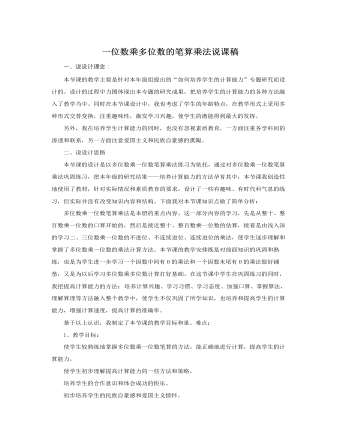
人教版新课标小学数学三年级上册一位数乘多位数的笔算乘法说课稿
三、说教法、学法从素质教育着眼点来看,要贯彻传授知识与培养能力相结合的原则,不仅要使学生学会知识,更要使学生会学、乐学、主动去学。为了更充分地发挥学生的主体地位,使他们能够自主学习,切实提高课堂教学效率。在教学方法上,采用谈话激趣、回忆交流、讨论归纳、强化练习等教学方法,循循诱导,让学生在比赛、游戏、练习、合作中自主学习,巩固和拓展所学知识。四、说教学过程“将课堂还给学生,让课堂焕发生命的活力”“努力营造学生在教学活动中自主学习的时间和空间”从这种设计理念出发,为了更好的达到教学目标,突出重点,增强教学效果,使学生计算能力得到真正发展,我对本节课设计如下几个环节:(一)、激趣导入。同学们,这几天我们一直在学习多位数乘一位数的知识,你们想不想知道我们今天要学习什么知识?
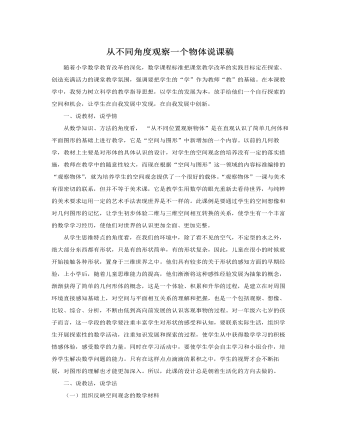
人教版新课标小学数学五年级上册从不同角度观察一个物体说课稿
(三)实践性数学是一种工具,一种将自然、社会运动现象法则化、简约化的工具。数学学习的最重要的成果就是学会建立数学模型,用以解决实际问题。因此,在这节课中,大量地创设条件,让学生把课堂中所学的知识和方法应用于生活实际之中,“学以致用”,让学生切实感受到生活中处处有数学。如上课伊始的猜冰箱,课中观察玩具、用品,给熊猫照相等,都采用了贴近学生生活的材料,旨在联系生活,开阔视野,同时延伸学习,使学生能从看到的物体的某一个面,联想到整个物体的形状,培养其观察立体实物的能力,建立初步的空间观念,发展形象思维。本课的所有教学环节都注重借助学生生活中常见的事物为知识载体,意在让学生感悟到“数学就在我们身边,生活离不开数学”。二、需进一步探究的问题“观察物体”的内容主要是对简单物体正面、侧面、上面形状的观察,因此本节课选择了大量生活中的实物让学生观察,旨在培养学生的空间观念。
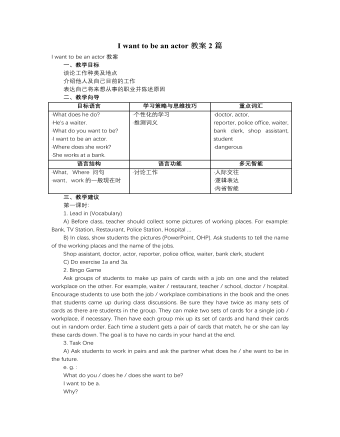
人教版新目标初中英语七年级下册I want to be an actor教案2篇
三、教学建议第一课时:1. Lead in (Vocabulary)A) Before class, teacher should collect some pictures of working places. For example: Bank, TV Station, Restaurant, Police Station, Hospital ...B) In class, show students the pictures (PowerPoint, OHP). Ask students to tell the name of the working places and the name of the jobs.Shop assistant, doctor, actor, reporter, police office, waiter, bank clerk, studentC) Do exercise 1a and 3a.2. Bingo GameAsk groups of students to make up pairs of cards with a job on one and the related workplace on the other. For example, waiter / restaurant, teacher / school, doctor / hospital. Encourage students to use both the job / workplace combinations in the book and the ones that students came up during class discussions. Be sure they have twice as many sets of cards as there are students in the group. They can make two sets of cards for a single job / workplace, if necessary. Then have each group mix up its set of cards and hand their cards out in random order. Each time a student gets a pair of cards that match, he or she can lay these cards down. The goal is to have no cards in your hand at the end.3. Task OneA) Ask students to work in pairs and ask the partner what does he / she want to be in the future.e. g. :What do you / does he / does she want to be?I want to be a.Why?Because it's (adj).B) Vocabulary: Section B, 1a4. Homework 1.2.
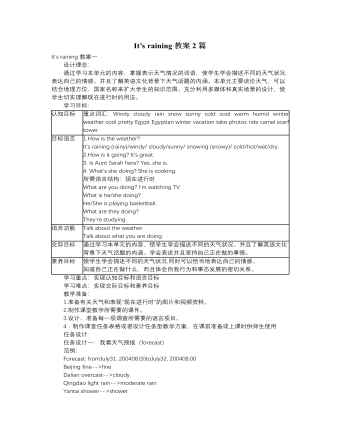
人教版新目标初中英语七年级下册It’s raining教案2篇
1 Each group choose one place to describe and what you are doing in it Choose one place, and describe what they are doing 2 Move around the room and give suggestions Talk about it and write it down 3 Ask one to show their works and act it Choose one of each group to make a report 4 Evaluate the best group and the best reporter Choose the best one Homework Ask your friends their ideal place and write about it教学反思:新课程标准中强调学生在课堂中的主体地位,在综合课中他们的主体地位就更加突出。在各个活动中给不同程度的学生不同层次的任务,让各层面的学生都有表现发挥的机会,从而产生对英语的兴趣。使用照片图片多媒体来辅助教学,效果更好。同时让了解其他国家风景,风俗的同学介绍ideal place,增加学生的背景知知识,实现跨学科交流的目的。教案点评:采用任务型教学模式,在各个活动中给不同程度的学生不同层次的任务,让各层面的学生都有表现发挥的机会,从而产生对英语的兴趣。使用照片图片多媒体来辅助教学,效果更好。让了解其他国家风景,风俗的同学介绍ideal place,增加学生的背景知识,实现跨学科交流的目的。
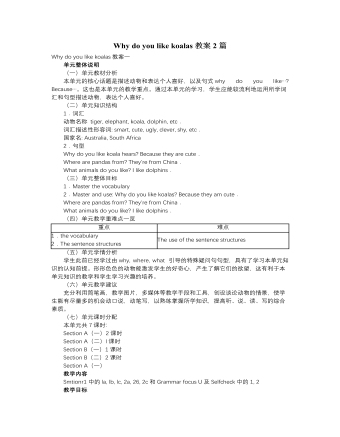
人教版新目标初中英语七年级下册Why do you like koalas教案2篇
单元整体说明(一)单元教材分析本单元的核心话题是描述动物和表达个人喜好,以及句式why do you like…? Because…。这也是本单元的教学重点。通过本单元的学习,学生应能较流利地运用所学词汇和句型描述动物,表达个人喜好。(二)单元知识结构1.词汇动物名称 tiger, elephant, koala, dolphin, etc.词汇描述性形容词: smart, cute, ugly, clever, shy, etc.国家名: Australia, South Africa2.句型Why do you like koala hears? Because they are cute.Where are pandas from? They're from China.What animals do you like? I like dolphins.(三)单元整体目标1.Master the vocabulary2.Master and use: Why do you like koalas? Because they am cute.Where are pandas from? They're from China.What animals do you like? I like dolphins.(四)单元教学重难点一览(五)单元学情分析学生此前已经学过由why, where, what 引导的特殊疑问句句型,具有了学习本单元知识的认知前提。形形色色的动物能激发学生的好奇心,产生了解它们的欲望,这有利于本单元知识的教学和学生学习兴趣的培养。
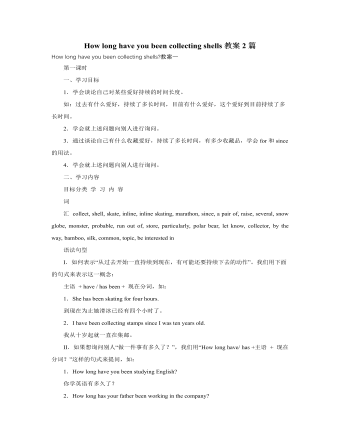
人教版新目标初中英语八年级下册How long have you been collecting shells教案2篇
Step Ⅱ Show the new words on the screen and teach the new words. Read the new words to students and ask them to repeat.Step Ⅲ 3aThis activity introduces new vocabulary and provides reading practice using the target language.In this activity first look at the four pictures.T: What can you see in the pictures?Ss: Four snow globes.T: Right. There are four snow globes in the pictures. And what are they?Ss: They are a monster, two polar bears, two penguins and a birthday cake.Write these words on the blackboard: snow globe; monster; polar bear; penguin and birthday cake. Read them to the class and ask students to repeat each one. Make sure students understand each word.Use a computer to show the E-mail message on the screen and read the message to students.Get students to read the e-mail on their own, and then draw lines connecting each snow globe and its description.Correct the answers.AnswersA line should connect each snow globe picture with the words that describe it in the letter.Step Ⅳ 3bThis activity provides writing practice using the target language.First review Activity 2a on Page 47.Then ask students to complete the message according to Activity 2a.Some partial sentences are given to students. Write about one person's collection.When students work, walk around the room checking the progress and offering help as needed.When they finish, ask some students to read their messages to the class.
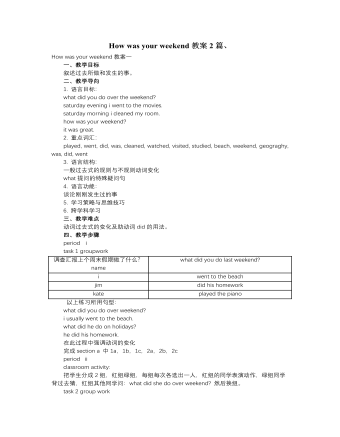
人教版新目标初中英语七年级下册How was your weekend教案2篇
Teaching Goal:1. General aims:Talk about recent past events2. Particular aims:A. Language Focus.Talk about recent past events and think of the past events.B. Language goalsHow was….?It was …What did …do over the weekend?C. Language structures:(1). How was your weekend? I was great. Pay attention to no form.(2). What did you do over the weekend? I played soccer. We went to the beach.D. Useful words and phrases:Words: was, did, went, beach, over, project, test, wasn’t, false, number, geography, spend, week, most, mixture, their, had, little, cook, read, saw, change, everyone, sit, sat, no, anythingPhrases: did one’s homework, played soccer, cleaned my room, went to the beach, played tennis, went to the movies, on Saturday morning, over the weekend, cook … for, what about, do some reading, have a party, talk show, go shoppingE. Grammar language:Present simple past tenseRegular and irregular verbsF. Learning strategies:Tour and holidaysG. Interdiscipinary:H. Emotion and manner:Teaching time: 5 periodsTeaching procedures:Period One教学步骤、时间 教师活动 学生活动 媒体应用Step 1Free talk 3’ Ask some questions like:Who’s on duty today?What’s the weather like? Answer and talk about something.让同学们回答下列问题1. Do you like weekend? (Let some students answer)It takes them three minutes to talk about the question.2. Why do you like weekend? (let the students answer) Most of the students like the weekend此时教师用汉语问:“在周末期间问你干了什么?这句话用英语这么回答?Let the students guess.At last the teacher give them right answer3. What did you do over the weekend?(板书、学习)
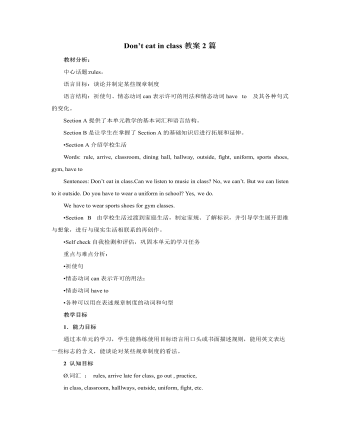
人教版新目标初中英语七年级下册Don’t eat in class教案2篇
Don’t fight. =You can’t fight. (板书,教读)教师把这些句子板书在黑板上,并请学生大声整齐地读祈使句和“can’t”句型,并让学生注意两种句型表达形式的不同和转换,“Don’t …=You can’t…”;并对学生说:These are our school rules. (板书,教读) You can’t break the school rules. Don’t break the school rules.(板书,教读)步骤3 :Practicea. T: Now, each of the students is breaking one of these rules.Please finish 1a.学生看图,完成1a的内容,检查答案并大声朗读校规。b. 听录音,完成1b,选出四位学生都违反了哪条校规;听之前,学生要读会英文名。c. 请两位学生朗读1c部分的句型;要求学生两人一组对话表演,SA扮演外校转来新生,SB告知本校校规。(学生可经过讨论,多说出他们想到的校规,不必只限于书上;教师应给予帮助)2) 第二课时(2a~4)步骤1 :warming up of revisionT: What are the rules at your school?学生使用“can”或祈使句表达各条校规;其中老师可引出“eat in the cafeteria outside”的表达。步骤2 :Practicea.T: Christina is an exchange student. She doesn’t know the rules. Let’s listen, what activities they’re talking about?学生听第一遍时,完成2a;第二遍时,完成2b;b. 请学生领读2c部分,看着2a完成的表格,理解2c活动的要求;分成小组针对2a进行问答;
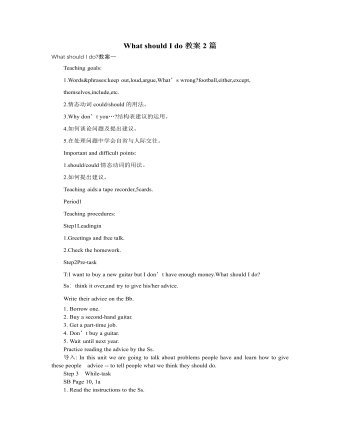
人教版新目标初中英语八年级下册What should I do教案2篇
说明:在帮Li Lei提建议的同时,教育学生如何学好英语。第三课时教学目标1. 语言目标:a) 词汇: Original, in style, haircut, the same as.b) 语言结构:My friend wears the same clothes and has the same haircut as I do.2. 能力目标:大多数学生能够谈论自己喜欢哪种服装,提高查找信息的能力。3. 情感目标:学会如何与朋友相处,要有自己对时尚的看法。教学重点掌握一些重要词汇。教学难点学会谈论问题,并能提出书面建议。◆教学突破首先针对Erin的问题,提出个人的建议,模仿2c部分的对话展开双人交际Pair-work;听老师诵读3a部分的信件,并找出LEFT OUT的问题所在;学生完成3b部分的内容,给Left Out提出书面的建议;学以口头形式提出自己目前存在的某个问题,讲给大家听,让同学们给自己提出一个建议,并作笔录;学生两、三个人分成一组,随意性地进行口语交际,谈论P14的第4部分的某个问题,相互交换意见。
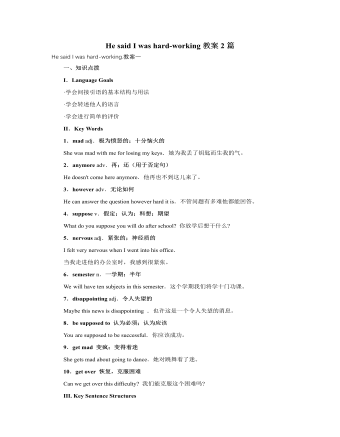
人教版新目标初中英语八年级下册He said I was hard-working教案2篇
This activity introduces some new vocabulary and provide oral practice using the target language.Task 1 . Ask four students to stand in front of the class, and the teacher asks them the following questions as a reporter.1.What are you going to do when you grow up?2.What are you going to do next week?3.What are going to do after school?The students will give different answers, then ask a good student to report what they said.I am going to e a doctor.What did she say?----------She said she was going to be a doctor.I am going to have a party on Friday night.What did he say?-------He said he was going to have a party on Friday night.I am going to do my homework.What did she say ?------ She said she was going to do her homework.I am going home after school.What did she say?-----She said she was going home after school.Say In this unit we are going to learn to use words like to report what someone said.Task 2. Read the instructions. Then ask a student to read the four questions. And write the words on the Bb. Explain what soap opera is.Task 3. Ask the students to Look at the pictures, point out the TV screens in the picture. Ask one girl to read what Marcia said.What did Marcia say? She said She said she was having a surprise party for Lana on Friday night. Repeat the other pictures in the same way.Activity3. Listen and number the pictures in activity 1a.
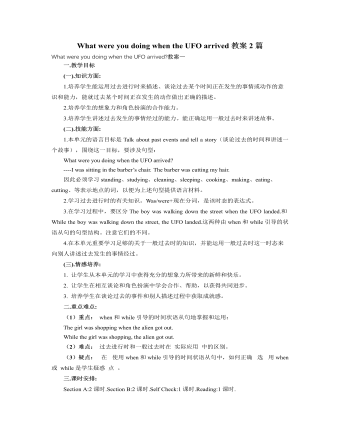
人教版新目标初中英语八年级下册What were you doing when the UFO arrived教案2篇
(一).知识方面: 1.培养学生能运用过去进行时来描述、谈论过去某个时间正在发生的事情或动作的意识和能力,能就过去某个时间正在发生的动作做出正确的描述。 2.培养学生的想象力和角色扮演的合作能力。 3.培养学生讲述过去发生的事情经过的能力。能正确运用一般过去时来讲述故事。 (二).技能方面: 1.本单元的语言目标是Talk about past events and tell a story(谈论过去的时间和讲述一个故事),围绕这一目标,要涉及句型: What were you doing when the UFO arrived? ----I was sitting in the barber’s chair. The barber was cutting my hair. 因此必须学习standing、studying、cleaning、sleeping、cooking、making、eating、cutting、等表示地点的词,以便为上述句型提供语言材料。2.学习过去进行时的有关知识。Was/were+现在分词,是该时态的表达式。 3.在学习过程中,要区分The boy was walking down the street when the UFO landed.和While the boy was walking down the street, the UFO landed.这两种由when和while引导的状语从句的句型结构。注意它们的不同。
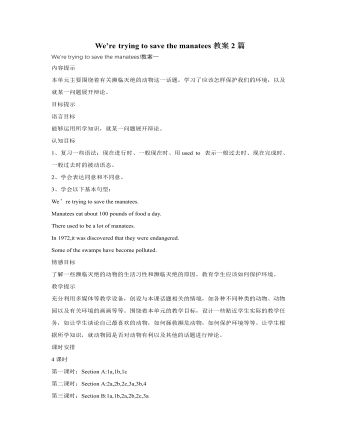
人教版新目标初中英语九年级下册We’re trying to save the manatees教案2篇
本单元主要围绕着有关濒临灭绝的动物这一话题,学习了应该怎样保护我们的环境,以及就某一问题展开辩论。目标提示语言目标能够运用所学知识,就某一问题展开辩论。认知目标1、复习一些语法:现在进行时、一般现在时、用used to 表示一般过去时、现在完成时、一般过去时的被动语态。2、学会表达同意和不同意。3、学会以下基本句型:We’re trying to save the manatees.Manatees eat about 100 pounds of food a day.There used to be a lot of manatees.In 1972,it was discovered that they were endangered.Some of the swamps have become polluted.情感目标了解一些濒临灭绝的动物的生活习性和濒临灭绝的原因,教育学生应该如何保护环境。教学提示充分利用多媒体等教学设备,创设与本课话题相关的情境,如各种不同种类的动物、动物园以及有关环境的画画等等。围绕着本单元的教学目标,设计一些贴近学生实际的教学任务,如让学生谈论自己最喜欢的动物,如何拯救濒危动物,如何保护环境等等。让学生根据所学知识,就动物园是否对动物有利以及其他的话题进行辩论。
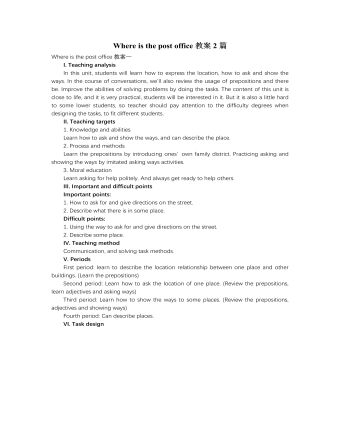
人教版新目标初中英语七年级下册Where is the post office教案2篇
Period 2 (3a----Section B 2c)Preview(Pre-task): Key points: What laAdd another information about their pen pals----their language on the cardnguage does she/he speak?She/He speaks....Does she/he have any brothers and sisters? Does she/he speak English?Preview(Pre-task): Add another information about their pen pals----their language on the cardKey points: What language does she/he speak?She/He speaks....Does she/he have any brothers and sisters? Does she/he speak English?Step 1 Revision1.Revisionand dictation of the new words 2.Revise the drills they learned yesterday.(by pairwork and grammar exercise)Step 2 Leading-inT has a conversation with one student. The conversation is following:---Do you have a pen pal?---Yes, I do.---What's your pen pal's name? ---His/Her name is....---Where is your pen pal from? ---He/She is from...---Where does he/she live? ---He/She lives in....---What language does he/she speak?He/She speaks...Write the new words on the Bb. They are following: EnglishChineseJapaneseFrenchStep 3 LearnLearn the new words with the whole class.Finish 3a with the students3b Pairwork T still does an example with one student Then the Ss practise in pairs. The example is following:--Curry Muray is my pen pal. He is from the United States.---What language does he speak?
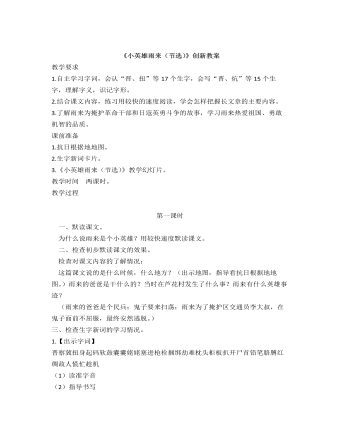
部编人教版四年级下册《小英雄雨来》创新教案
(二)提问:夜校的学习条件怎样?雨来在夜校里受到什么教育?默读第二段。指导朗读:“我们是中国人,我们爱自己的祖国。”“我们——是——中国人,我们——爱——自己的——祖国。”讨论段意和小标题。(段意:雨来上夜校,受到爱国主义教育。)(小标题:“雨来上夜校。”)(三)学习第三段。默读课文,提问:这段主要说了几层意思?学生默读课文,小组交流,展示如下:(两层意思:第一层从“有一天”至“只从街上传来一两声狗叫”,主要写鬼子开始扫荡了;第二层从“第二天”至这段结束,主要写雨来为掩护交通员李大叔,被鬼子捆绑起来了。)指导朗读第二层。重点朗读:“他抬头一看,是李大叔。”“咦!这是什么时候挖的洞呢?”“把缸搬回原地方。你就快到别的院里去,对谁也不许说。”讨论段意和小标题。段意:(雨来为掩护交通员李大叔,被鬼子捆绑起来了。)(小标题:“雨来掩护李大叔”。)
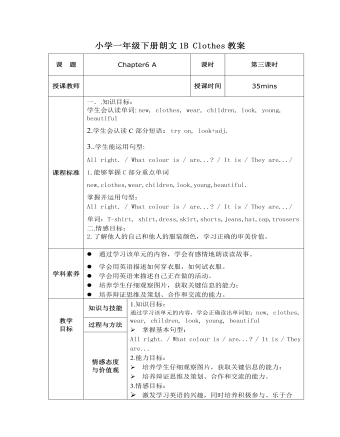
小学一年级下册朗文1B Clothes教案
一..知识目标:学生会认读单词: new, clothes, wear, children, look, young, beautiful2.学生会认读C部分短语:try on, look+adj. 3..学生能运用句型:All right. / What colour is /are...? / It is / They are.../1.能够掌握C部分重点单词new,clothes,wear,children,look,young,beautiful.掌握并运用句型:All right. / What colour is /are...? / It is / They are.../单词:T-shirt, shirt,dress,skirt,shorts,jeans,hat,cap,trousers二.情感目标:2.了解他人的自己和他人的服装颜色,学习正确的审美价值。
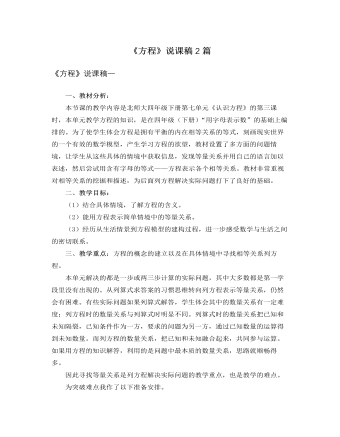
北师大版小学数学四年级下册《方程》说课稿2篇
3、变换角度,深入思考第三幅情境图隐含着多样的等量关系,也正是引发学生数学思考的最佳情境。根据学生认识的深入程度,可适当让学生体会到等式的“值等”和“意等”,并放手让学生探究,根据不同的认识找到不同的等量关系,列出等量关系不同的同解方程。在教学中,先引导孩子发现情境中的基本相等关系:2瓶水的水量+一杯水的水量=一壶水的水量,并且列出等式2z+200=2000,在此基础上,再引导孩子发现其他的等量关系。在这一过程中,充分激发孩子探求知识的欲望,调动孩子思考的主动性和灵活性,从而找到多样化的等量关系,并进一步提高孩子解决数学问题的能力。4、建立概念,判断巩固在前面教学的基础上总结、抽象出方程的含义。通过三道例题的简洁数学式子表达,让小组合作寻找他们的共同特点,从而建立方程的概念。“含有未知数”与“等式”是方程概念的两点最重要的内涵。并通过“练一练”让学生直接找出方程。
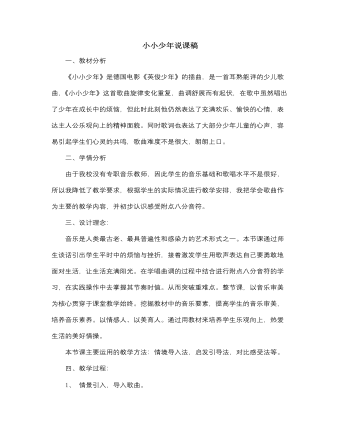
人音版小学音乐四年级下册小小少年说课稿
3、请同学朗读歌词。4、聆听歌曲《小小少年》。5、学习附点八分音符(1)看一看歌曲中用的最多的节奏是什么呢?用笔画出来。(2)听一听老师范唱与歌曲范唱的区别,哪种唱法好?(教师把附点音符改成八分音符来唱)(3)师从连音线的图解中讲解附点八分音符时值。得出结论:附点八分音符是在八分音符的基础上,延长把八音符的一半。(4)听辨练习。6、跟琴学唱曲谱,感受歌曲的弱起节奏。7、演唱歌曲分多种形式指导学生演唱歌曲。鼓励学生用明亮略带忧虑的情绪来演唱这首歌8、在《小小少年》中小主人公遇到了不小的烦恼,他被烦恼打倒从此消沉了么?他是怎样做的?我们同学的年龄跟他相仿,也许在某一天你的烦恼也会悄悄来临,希望你能象他一样用自己的智慧和爱心将困难克服掉,勇敢的迎接生活的挑战,做一个生活的强者!
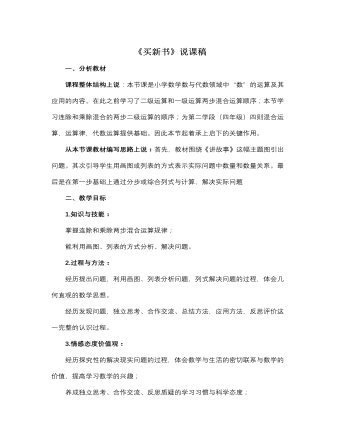
北师大版小学数学三年级下册《买新书》说课稿
2.应用意识方面,解决问题能力较差。一方面是符号意识、应用意识需要发展,从现实问题抽象出数学问题的能力和主动用数学思想分析现实问题的习惯。二是分析问题、解决问题的策略缺乏、灵活使用的能力不足(几何直观、模型思想、归纳、类比、逆向思考等方法)。五、教法、学法教法:利用谈话法,引导学生思考、探究的过程,实现教师主导下的学生的自主建构。利用讲解法,在探究学习的基础上,教师和学生共同对重点、难点进行梳理,引导学生建立清晰、系统的知识结构。利用练习法,巩固知识,发展学生的运算能力、符合意识、应用意识。学法:自主探究,有利于形成主动思考的习惯,思维能力获得提高。成功的探索使其获得理智感,有益于学习兴趣的培养。合作学习,交流比较,质疑反思的经验有利于学生创新能力的提升。合作交流同时也促进个性、社会性的发展。
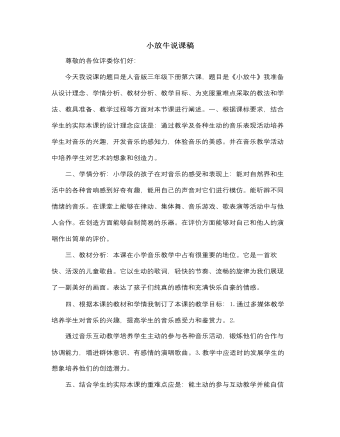
人音版小学音乐三年级下册小放牛说课稿
有感情就有想象,从而形成创造思维。老师可依据本课的内容及情绪鼓励引导学生进行即兴创编活动。充分挖掘学生的潜力。创编一些与课本情绪一致的节奏、诗歌、故事、游戏、音乐表演等。(创编的内容和形式可以根据教材而定)根据学生的个性差异对每一位同学都应该多关心多鼓励。构建和谐团结民主的氛围。引导学生积极讨论共同参与,培养学生乐观的学习态度和友爱的精神。锻炼合作与协调能力,增进群体意识,培养团队精神。第五环节:自评互评培养鉴赏力本课的教学评价我是以表扬和鼓励为主,随时引导学生在音乐活动中开展自评互评和老师的随堂评价,以提高学生的乐感和审美能力。我评价他们的重点是能否积极自信的参与音乐表现、能否与其他的同学协作配合、在课堂小结时我还安排了学生谈一谈这节课的感想如:这节课你学到了什么?歌曲中你最喜欢那一句?在课堂上对那些有创意的学生我还及时的发给他们小奖品。小结:以上是本课的总阐述,不到之处请评委指正。

人音版小学音乐四年级下册小纸船的梦说课稿
第一环节“情景导入”,现代信息技术在这一环节体现非常充分,让学生欣赏一些关于船的图片第二环节“反复感受,轻松学歌”,音乐是听觉的艺术,在这一环节中,我首先让学生通过反复聆听来感受这首歌曲,接着采用模唱法和听唱法相结合让学生在轻松愉快的氛围中学会了本课歌曲。第三环节“表现歌曲”这是本课中最出彩的一个环节。在前面的几个环节中层层铺垫,为学生积累了很多艺术实践和经验,这时让学生拿着自己的船进行音乐表现,学生已经没有困难,而且能够表演得很到位,将整堂课推向高潮。最后的拓展部分引发学生对祖国热爱,激励他们努力学习而使学生喜欢音乐,感受音乐带给我们的美以及对未来的憧憬和理想。让他们在以后的学习生活中能奋发向上!





















